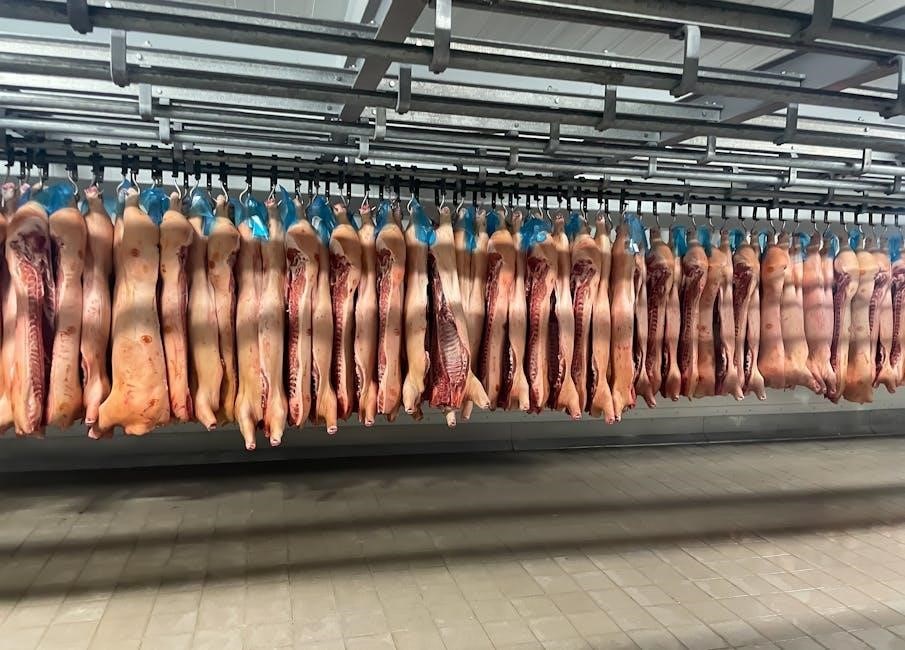refrigeration & air conditioning technology 9th edition pdf
- by blaise

Overview of Refrigeration & Air Conditioning Technology 9th Edition
The 9th Edition of Refrigeration & Air Conditioning Technology provides a comprehensive update on sustainable practices, modern technologies, and industry advancements. It emphasizes green awareness and integrates cutting-edge solutions for energy efficiency and environmental impact reduction. The text is structured to enhance learning through practical applications and real-world scenarios, making it a valuable resource for both students and professionals in the HVAC/R field. This edition reflects the latest trends and innovations, ensuring readers are well-prepared to meet current and future industry demands.
1.1 Key Features of the 9th Edition
The 9th Edition of Refrigeration & Air Conditioning Technology is designed to meet the evolving demands of the HVAC/R industry, focusing on sustainable practices and modern innovations. It includes updated content on application-based technology solutions, emphasizing real-world applications to enhance learning. A significant emphasis is placed on green awareness, highlighting environmentally friendly technologies and their importance in reducing the environmental impact of HVAC/R systems. The edition also explores advanced topics such as the use of carbon dioxide as a refrigerant in industrial applications and the integration of 2-stage rotary CO compressors for improved efficiency. Additionally, the text incorporates over 250 lab exercises, providing hands-on practice for students and professionals. The 9th Edition is supported by an eTextbook format, making it accessible to a wider audience. With its comprehensive coverage of the latest technologies and practices, this edition serves as a valuable resource for both education and professional development in the HVAC/R field.
1.2 Chapter Breakdown and Content Structure
The 9th Edition of Refrigeration & Air Conditioning Technology is organized into a logical and comprehensive structure, ensuring a progressive learning experience. The text begins with foundational concepts such as thermodynamics, refrigeration principles, and air conditioning systems. Subsequent chapters delve into advanced topics like sustainable technologies, energy-efficient designs, and the integration of modern tools like 2-stage rotary CO compressors. Each chapter is designed to build on the previous one, providing a clear pathway from basic to complex subject matter. The edition also includes dedicated sections on application-based solutions, diagnostic techniques, and troubleshooting common issues, making it a practical resource for both students and professionals. The content is supplemented with lab exercises and real-world case studies, reinforcing theoretical knowledge with hands-on applications. This structured approach ensures that readers gain a holistic understanding of HVAC/R systems, preparing them for industry challenges and advancements.

Importance of Sustainable Technology in Modern HVAC/R Systems
Sustainable technology plays a pivotal role in modern HVAC/R systems, addressing environmental concerns and promoting energy efficiency. The 9th Edition emphasizes the integration of green technologies and eco-friendly refrigerants, such as carbon dioxide, to reduce greenhouse gas emissions. By adopting sustainable practices, the HVAC/R industry can mitigate its environmental impact while maintaining system performance. The edition highlights the importance of energy-saving solutions and renewable energy sources, aligning with global efforts to combat climate change. These advancements not only benefit the environment but also offer cost savings for businesses and consumers. As the demand for sustainable systems grows, the HVAC/R industry must continue to innovate and adopt these technologies to ensure a sustainable future. The 9th Edition serves as a critical resource for understanding and implementing these essential changes.
The Role of the 9th Edition in HVAC/R Education
The 9th Edition of Refrigeration & Air Conditioning Technology serves as a cornerstone in HVAC/R education, offering a comprehensive and structured approach to learning. Designed for both students and professionals, the text provides in-depth coverage of modern technologies, sustainable practices, and industry standards. With over 250 lab exercises, it ensures hands-on practice, bridging the gap between theoretical knowledge and practical application. The edition emphasizes green awareness and energy-efficient solutions, preparing learners for the challenges of a rapidly evolving industry. Its clear and concise content, combined with real-world scenarios, makes it an indispensable resource for understanding the latest advancements in HVAC/R systems. By integrating traditional learning systems with modern innovations, the 9th Edition equips future professionals with the skills and knowledge needed to excel in the field. This edition is a vital tool for educators and learners alike, fostering a deeper understanding of refrigeration and air conditioning technologies.

Recent Advances in Refrigeration and Air Conditioning
Recent advances focus on sustainable technologies and energy-efficient solutions. The integration of carbon dioxide as a refrigerant and application-based technology solutions highlights key developments, aiming to enhance system performance while reducing environmental impact and improving efficiency.
4.1 Application-Based Technology Solutions
Application-based technology solutions are revolutionizing the HVAC/R industry by optimizing system performance for specific use cases. These solutions leverage advanced components like smart sensors and IoT-enabled devices to enhance efficiency and adaptability. For instance, systems can now automatically adjust cooling levels based on occupancy or environmental conditions, reducing energy waste. The 9th Edition highlights how these technologies are integrated into modern designs, ensuring tailored approaches for industrial, commercial, and residential applications. A key focus is on energy-saving and environmentally friendly outcomes, aligning with global sustainability goals. By prioritizing application-specific solutions, the industry achieves higher performance, lower operating costs, and reduced emissions. This chapter provides detailed insights into real-world implementations and their benefits, supported by case studies and practical examples from the textbook.
4.2 Carbon Dioxide as a Refrigerant in Industrial Applications
Carbon dioxide (CO₂) has emerged as a promising refrigerant in industrial applications due to its environmental sustainability and low global warming potential. Unlike traditional hydrofluorocarbons (HFCs), CO₂ is a natural refrigerant, making it an attractive alternative for industries aiming to reduce their environmental footprint. The 9th Edition highlights how CO₂-based systems are being increasingly adopted in large-scale industrial processes, such as food processing and cold storage, where high efficiency and reliability are critical. These systems often utilize 2-stage rotary CO compressors, which enhance performance and adaptability in demanding industrial environments. The textbook also explores the challenges associated with CO₂ refrigeration, including higher operating pressures, and provides insights into innovative solutions to overcome these limitations. By focusing on CO₂ as a refrigerant, the industry is moving toward more energy-efficient and eco-friendly practices, aligning with global sustainability goals and reducing long-term environmental impact.

Energy Efficiency in Modern Refrigeration Systems
Energy efficiency has become a cornerstone of modern refrigeration systems, driven by the need to reduce energy consumption and lower operational costs. The 9th Edition emphasizes the importance of optimizing system performance while minimizing environmental impact. Advances in technology, such as smart controls and variable-speed compressors, enable precise temperature management and significant energy savings. These innovations are particularly relevant in industrial applications, where energy consumption is high. The integration of application-based technology solutions ensures that cooling systems operate at peak efficiency, tailored to specific industrial needs. Additionally, the use of advanced materials and designs in heat exchangers further enhances energy performance. By prioritizing energy efficiency, modern refrigeration systems not only reduce energy costs but also contribute to global sustainability goals. The 9th Edition provides in-depth insights into these technologies, offering practical guidance for engineers and technicians to implement energy-saving strategies effectively.

The Integration of 2-Stage Rotary CO Compressors
The integration of 2-stage rotary CO compressors represents a significant advancement in refrigeration and air conditioning technology. These compressors are designed to optimize performance in both refrigeration and heat pump applications, offering improved efficiency and capacity modulation. By utilizing a two-stage compression process, these compressors can handle varying load demands more effectively, reducing energy consumption and operational costs. Additionally, the incorporation of vapor injection technology enhances cooling capacity during high-temperature conditions, making them suitable for diverse industrial and commercial applications. The 9th Edition highlights how these compressors contribute to sustainable practices by minimizing energy waste and reducing environmental impact. Their compact design and reliability make them a preferred choice for modern HVAC/R systems. This technology aligns with the growing emphasis on energy efficiency and eco-friendly solutions in the industry, as discussed in the 9th Edition of Refrigeration & Air Conditioning Technology.

Diagnostic Techniques for HVAC/R Systems
Diagnostic techniques for HVAC/R systems are essential for maintaining efficiency, reducing downtime, and ensuring optimal performance. The 9th Edition emphasizes the importance of advanced diagnostic tools and methodologies to identify and resolve issues promptly. With the integration of modern technologies, such as digital diagnostic tools and smart sensors, technicians can now pinpoint problems with greater accuracy. These tools enable real-time monitoring of system parameters, allowing for proactive maintenance and minimizing operational disruptions. The text also highlights the role of data analytics in predicting potential failures and scheduling preventive maintenance, which is crucial for industrial and commercial applications.
The edition further explores common issues in HVAC/R systems, such as refrigerant leaks, compressor malfunctions, and control system errors. It provides detailed troubleshooting guides and best practices to address these problems effectively. By focusing on these diagnostic techniques, the 9th Edition equips professionals with the skills needed to ensure sustainable and energy-efficient system operation, aligning with the broader goals of modern HVAC/R practices.
Sustainable Practices in Refrigeration and Air Conditioning
Sustainable practices are central to modern HVAC/R systems, focusing on energy efficiency, green technologies, and environmental impact reduction. The 9th Edition highlights the adoption of eco-friendly refrigerants and energy-saving solutions to align with global sustainability goals and standards.
8.1 Green Awareness and New Technologies
Green awareness has become a cornerstone of modern HVAC/R systems, driving the adoption of environmentally friendly technologies. The 9th Edition emphasizes the importance of sustainable practices, highlighting advancements in eco-friendly refrigerants, energy-efficient designs, and reduced carbon footprints. New technologies such as carbon dioxide refrigeration systems and smart control systems are showcased, offering innovative solutions to traditional challenges. These technologies not only align with global sustainability goals but also enhance system performance and reliability. By integrating green awareness into its content, the 9th Edition prepares professionals and students to address environmental concerns while maintaining high standards of efficiency and productivity. The focus on new technologies underscores the industry’s shift toward cleaner, more responsible practices, ensuring a greener future for refrigeration and air conditioning systems.
8.2 Environmental Impact of Modern HVAC/R Systems
Modern HVAC/R systems play a significant role in reducing environmental impact through advanced technologies and sustainable practices. The 9th Edition highlights the importance of minimizing carbon emissions and addressing climate change. By adopting eco-friendly refrigerants, such as carbon dioxide, and improving energy efficiency, these systems contribute to a greener future. The integration of smart controls and renewable energy solutions further enhances their environmental performance. However, the industry must balance innovation with responsible resource use to mitigate long-term ecological effects. The 9th Edition emphasizes the need for continuous improvement in system design and operation to reduce environmental impact while maintaining high performance standards. By focusing on these advancements, the text provides a roadmap for creating HVAC/R systems that are both effective and sustainable, aligning with global efforts to combat climate change and promote environmental stewardship.

The Role of Chillers in Industrial Processes
Chillers are essential components in various industrial processes, providing reliable and efficient cooling solutions. The 9th Edition emphasizes their critical role in maintaining optimal temperatures for manufacturing, food processing, and pharmaceutical applications. By integrating advanced technologies, such as 2-stage rotary CO compressors and vapour injection systems, modern chillers achieve higher performance and energy efficiency. These systems are designed to meet the demanding requirements of industrial operations, ensuring consistent cooling and minimizing downtime. The text also explores how chillers contribute to energy savings and environmental sustainability, aligning with global efforts to reduce carbon emissions. With detailed insights into chiller design, operation, and maintenance, the 9th Edition serves as a comprehensive guide for professionals seeking to optimize industrial cooling systems. This focus on chillers underscores their importance in driving efficiency and productivity across various industries.

Troubleshooting Common Issues in HVAC/R Systems
Troubleshooting common issues in HVAC/R systems is crucial for maintaining efficiency, reliability, and performance. The 9th Edition provides detailed insights into identifying and resolving frequent problems, such as refrigerant leaks, compressor malfunctions, and control system errors. Modern systems, especially those utilizing 2-stage rotary CO compressors and carbon dioxide as a refrigerant, require specialized diagnostic techniques. The text emphasizes the importance of understanding system design and operation to pinpoint root causes effectively. Practical examples and step-by-step procedures guide technicians through real-world scenarios, ensuring timely and accurate repairs. Additionally, the edition highlights how application-based technology solutions can simplify troubleshooting by optimizing system configuration. By addressing these challenges, the 9th Edition equips professionals with the skills to maintain seamless operation in industrial and commercial settings, minimizing downtime and enhancing overall system performance. This focus on troubleshooting reflects the growing need for efficient and sustainable HVAC/R solutions in today’s demanding environments.

Future Trends in Refrigeration and Air Conditioning Technology
The future of refrigeration and air conditioning technology is poised for significant advancements, driven by the need for sustainability and energy efficiency. Emerging trends include the adoption of natural refrigerants like carbon dioxide and ammonia, which reduce environmental impact. Smart technologies, such as IoT-enabled systems, are expected to optimize performance by enabling real-time monitoring and adaptive controls. The integration of AI and machine learning will enhance predictive maintenance, reducing downtime and improving system reliability. Additionally, the development of inverter-driven compressors and advanced heat exchanger designs promises to increase efficiency while lowering energy consumption. As global regulations tighten, manufacturers are focusing on eco-friendly solutions that align with climate goals. These innovations highlight the industry’s commitment to sustainability and performance, setting the stage for a greener and more efficient future in HVAC/R systems. By embracing these trends, the 9th Edition prepares professionals to lead the next generation of refrigeration and air conditioning technology.

Accessibility of the 9th Edition for Students and Professionals
The 9th Edition of Refrigeration & Air Conditioning Technology is designed to be highly accessible for both students and professionals. It is available in various formats, including eTextbooks and downloadable PDFs, ensuring flexibility for different learning preferences. The text incorporates clear explanations, detailed illustrations, and practical examples to facilitate understanding. Additionally, the edition is supported by online resources, such as lab manuals and test banks, which provide hands-on practice and assessment tools. The structured layout and comprehensive indexing make it easy to navigate and reference specific topics. Professionals can also benefit from its focus on real-world applications and industry updates, while students appreciate its alignment with curriculum requirements. This accessibility ensures that the 9th Edition serves as a valuable resource for anyone seeking to advance their knowledge in HVAC/R technology. Its widespread availability and user-friendly design make it a go-to reference for education and professional development in the field.
The 9th Edition of Refrigeration & Air Conditioning Technology stands as a comprehensive and forward-thinking resource for the HVAC/R industry. It effectively balances theoretical knowledge with practical applications, making it indispensable for both students and professionals. The emphasis on sustainable practices, energy efficiency, and green technologies aligns with global efforts to reduce environmental impact, ensuring the content remains relevant and timely. The inclusion of application-based solutions and discussions on cutting-edge refrigerants, such as carbon dioxide, highlights the edition’s commitment to innovation. Additionally, its accessibility in multiple formats, including eTextbooks and downloadable PDFs, enhances learning flexibility. Overall, the 9th Edition not only addresses current industry challenges but also prepares readers for future advancements in refrigeration and air conditioning technology. It serves as a cornerstone for education and professional development, fostering a deeper understanding of HVAC/R systems and their critical role in modern society. This edition is a testament to the evolving nature of the field and its importance in shaping a sustainable future.
Related posts:
Get the Refrigeration & Air Conditioning Technology 9th Edition PDF for free. Your ultimate guide to modern cooling systems and techniques.
Posted in PDF